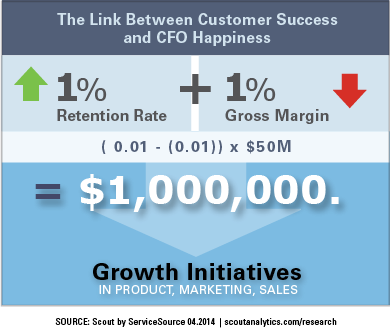If you’re a CFO of a SaaS business, one of your biggest challenges is gross margin. As we all know, gross margin is essentially the difference between the revenue for a subscription and the cost of fulfilling that subscription—and with the software industry’s seismic shift from an on-premises model to a SaaS model, we’ve watched gross margins go from about 99% to more like 70 to 80%. That’s a big change.
Unlike the old on-premises model, the SaaS model now has operations, customer success, and other functions to include in the gross margin equation. A SaaS company needs to fulfill on the terms of subscriptions, and that entails both “assets” (e.g., computers, bandwidth, operations) and “services” (e.g., on-boarding, adoption, retention).
The good news? Customer success organizations have a tremendous ability to increase gross margin—and that’s music to any CFO’s ears.
We usually think about customer success in terms of creating competitive advantage through the delivery of a differentiated customer experience along with differentiated value. But customer success teams can also create competitive advantage by adding incremental gross margin—which can then be used to drive growth through investments in development, marketing, and sales.
So how does that work? Let’s consider the dynamics of how gross margin can drive competitive advantage, outside of customer success. Consider data center operations, for example: One operational strategy is to use a service like Amazon Web Services to provide all your data center needs. If a company takes this approach, the company has set the lower limit on its operational efficiency around compute capacity—after all, Amazon has a set price for their services that the company has to pay. (By the way, the company’s competition can get the same price and have the same operational efficiency.)
On the other hand, the company can use a co-location data center to leverage capital more efficiently than AWS would, and hence decrease its operational costs. That decrease in operational costs can translate into increased gross margin—and that increased margin means an ability to invest in development, marketing, and sales to drive growth, which creates a competitive advantage over competitors who are using AWS. (Note that the growing trend is a hybrid model, where a SaaS company controls the fixed part of computing demand and uses AWS or another service to provide the elastic component.)
So let’s compare this example to how customer success can create a competitive advantage through increased margin: Unlike efficiency gains in the data center, efficiency gains in customer success can also coincide with increase customer retention rates—giving you in effect a “double bump” in increased margin.
For example, a customer success team can use marketing automation to nurture users and make on-boarding more efficient. These process improvements don’t just improve customer experience, they increase gross margin and create competitive advantage.
As the chart to the right shows, a percentage point in  increased efficiency combined with a percentage point in increased retention rates creates a two-point margin advantage. For a $50M SaaS business, that equates to $1M of investment in development, marketing, and sales.
increased efficiency combined with a percentage point in increased retention rates creates a two-point margin advantage. For a $50M SaaS business, that equates to $1M of investment in development, marketing, and sales.
The Implication
Customer success programs can be part of a multi-pronged approach to competitive advantage. Not only can customer success management create differentiated customer experience and value, but it can also create gross margin advantage through increased efficiency and retention rates.
The customer success teams that understand and leverage these dynamics can accelerate growth—and, of course, growth creates a virtuous cycle of investment and further growth within the customer success organization. Customer success teams can use these dynamics around gross margin to help secure investments, by using the “double bump” to justify customer success technology and automation with their CFO.






